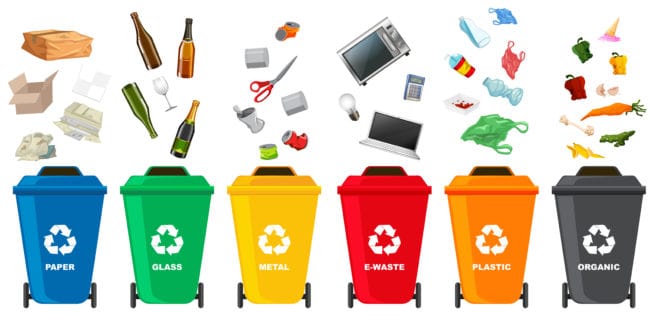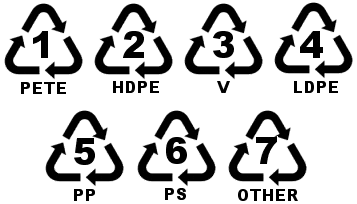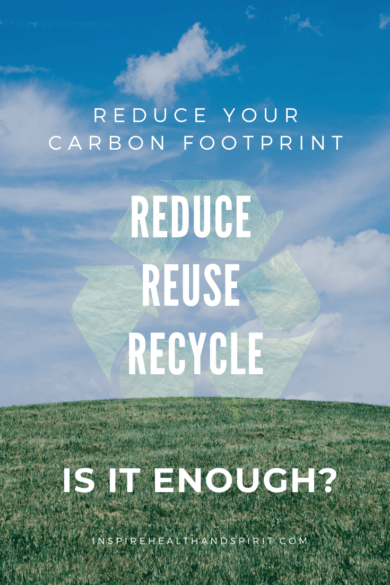What Are the Benefits of Recycling?
Reduce the amount of waste sent to landfills.
According to EPA more than 139 million tons of MSW, municipal solid waste, (52.1 percent) were landfilled.
Reduce pollution (by minimizing the need to source new raw material)
Conserve natural resources (plastic is made from oil and gas)
Saves energy (by recycling the material rather than making an item brand new)
Creates jobs in recycling and manufacturing
For every 1,000 tons of materials recycled creates 1.57 jobs, $76,000 in wages, and $14,101 in tax revenues in the US.
So you recycle. You put your plastic, bottles, and paper in a green recycle bin and place it out on the curb on your trash day. That’s it, you’ve done your part in ensuring all your recyclables are recycled.
Not so fast.
Some of those materials never even get to be recycled. Did you remember to clean and dry your bottles to make sure there is no food on or in that pizza box? Yes, if those bottles, cans, paper or cardboard have food or are dirty they are not recyclable.
If you have recyclables in your trash bin those will not be recycled. That trash can, bins goes to the landfill.
RECYCLE PROCESS
REDUCE REUSE RECYCLE
A truck picks up your recycle bin but then what happens to your plastic/recyclable? You may think oh we’re doing good for the planet and throwing it in the recycle bin. It’s going to be made into something else. You assume they’re going to be recycled, right? Surely, they are not going to a landfill?
WHAT REALLY HAPPENS

Collection
All the recyclable items tossed into your green bin still have to be sorted into categories. These categories are glass, plastic, metal, e-waste, paper and organic. Your recycle bin goes to a material recovery facility (MRF) for sorting, cleaning, and processing. Material that can be used for manufacturing is bought and sold.
The material must meet certain standards to be bought by manufacturers. The material can’t have too many impurities as it is competing with virgin materials for manufacturing. Again, make sure you cleaned your item allowing a higher probability of it being sorted for processing and recycled.
The recycling industry in the US alone in 2019 will bring in $7 Billion in total revenue. WOW!! Who knew recycling was a moneymaker? Not me. The recycling industry does and so do the manufacturers who gain the most.
Single-use plastics like straws and other small material are sorted out of the process and go to landfills.
Manufacturing
Material is then recycled and used to make items such as paper, newspaper, paper towels, paper bags, cardboard, toilet paper, and more.
Eventually, even recyclable items can no longer be recycled. It still has to go somewhere, but where?
A full 32% of the 78 million tons of plastic packaging produced annually is left to flow into our oceans; the equivalent of pouring one garbage truck of plastic into the ocean every minute. If we carry on, as usual, this is expected to increase to two per minute by 2030 and four per minute by 2050. By 2050, this could mean there will be more plastic than fish in the world’s oceans. At the moment, only 14% of global plastic packaging is collected for recycling and only 2% is reused as packaging.”
World Economic Forum
Recycling doesn’t do what you think it does?
Plastic Recycle Symbol

There are 7 Resin Identification Code (RIC). Recycle codes located on your plastic materials. The recycling symbol code was designed by The Society of the Plastics Industry (SPI) in 1988. It’s important to know that just because the item has a recycling number doesn’t mean the plastic can be recycled.
It’s been ingrained in us that if we see the recycle symbol on something that means it’s recyclable and we automatically toss it in the recycle bin.
That is not the case. The codes are listed below and whether or not they are recyclable.
RECYCLABLE 1 and 2
1 PET or PETE – Polyethylene Terephthalate aka soda bottles, water bottles, food packaging
2 HDPE – High-density Polyethylene aka Detergents, bleach, milk, motor oil bottles
Not Recyclable 3
3 PVC – Polyvinyl Chloride – Plastic piping, toys, furnishings
Not Recyclable 4 curbside but some communities allow it but not grocery bags
4 LDPE – Low-density Polyethylene aka Plastic wrap, grocery bags sandwich bags
Recyclable 5 by some curbside programs check your local community recycler
5 PP – Polypropylene aka Clothing, bottles, tubs, rope
Not Recyclable 6 & 7
6 PS – Polystyrene (Styrofoam) aka Cups, foam food trays, packing peanuts, to-go containers
7 – Other or Various applications
The plastics recycling rate in the US according to Resource Recycling over the last 5 years is:
2015 = 9%
2016 = 9.3%
2017 = 8.4%
Our friends across the pond have a 20% recycling rate in the UK. There is something there to be learned by the US for sure.
What Are the 3 Rs?
I’ve seen 3, 4, 5, 6, 7, even 10 r’s of waste management waste hierarchy. Very confusing but for the sake of sticking to the basics we’ll go off the EPA or US Environmental Protection Agency. And review the 3 R’s of Reduce, Reuse, Recycle.
According to the United States Environmental Protection Agency
EPA developed the non-hazardous materials and waste management hierarchy in recognition that no single waste management approach is suitable for managing all materials and waste streams in all circumstances. The hierarchy ranks the various management strategies from most to least environmentally preferred. The hierarchy places emphasis on reducing, reusing, and recycling as key to sustainable materials management.
United States Environmental Protection Agency
These are the things we as consumers can do to help in regards to the amount of disposable waste and preserve valuable, limited landfill space.
It’s important to resonate with limited landfill space. We do not have unlimited landfill space, thus causing the overflow to our oceans.
REDUCE
As it suggests reducing the amount of disposable waste. This doesn’t necessarily mean to not just get what you need to ask yourself before the purchase. Do I really need it, can I reuse it later?
REUSE
As it implies using the material over and over in the original form. This can even mean buying used items from a consignment store or buying reusable over disposable.
RECYCLE
This is the last on the list after reduce, reuse because it should be the last option for the material. This is the last resort not the go-to. Refer to what can actually be recycled vs. single-use.
Reducing and reusing are to limit the amount of waste that requires disposal. You cannot recycle an item over and over and over again. Eventually, you still have to get rid of it as it will be compromised and no longer recyclable.
“The most effective way to reduce waste is to not create it in the first place. Making a new product requires a lot of materials and energy – raw materials must be extracted from the earth, and the product must be fabricated then transported to wherever it will be sold. As a result, reduction and reuse are the most effective ways you can save natural resources, protect the environment and save money.”
EPA
Styrofoam (to-go containers)
Packing peanuts
Bubble wrap – unless there is a specific company that accepts it
Aerosol cans – with product and cap are dangerous and can cause fires
Plastic Bags – single-use bags like grocery bags
Straws
Sandwich/freezer bags
Plastic wrap/film
Chip bags
Soup or juice pouches – made of different materials and cannot be recycled
Wax cups
Dirty diapers
Pet waste/pee pads etc
No clothes, shower curtains, furniture
No medical waste
No garage waste – car parts, scrap metal, etc
Read more about single-use plastics and how it is harming our oceans here.
Every community and country will have different criteria for what can and cannot be recycled. Be sure to check your local guidelines.
We need to make recycling an option for all to have available to them so that we have the opportunity to do so. For instance, my neighborhood doesn’t have recycling available to us as pick up service. The HOA said it reached out to the current waste management company but they do not have this option available.
Then that was it. No option from this one particular company so we don’t have it. There doesn’t appear to be any further effort to obtain this either.
This shouldn’t be made hard for people to recycle and do your part.
Yes, recycling has its benefits if done properly and you follow the dos and don’ts of recycling 101.
It can definitely have an impact on the environment, but to say that recycling alone will improve our environment while we still have over consumption at play, plastics being dumped in our oceans, and mindless use of our impact on our home is not enough.
“The only material that doesn’t need disposal is the one we never made.”
Roland Geyer Industrial Ecologist.
You must help with reducing not only the consumerism of the materials. But manufacturers who seem willing to place the responsibility back on the consumer must also make the change in recycling their products. Deposit system for glass bottles etc.
Placing blame doesn’t help solve any issue. It just keeps us stagnant.
I believe there is a solution to every problem. Will everyone like it? Probably not. Which is why things have to be passed as law for some to follow. But if you don’t then one day you’ll look up and wonder why no one told you that you should limit your use of plastics, recycle more often and reuse items over and over.
Except it is being said but your eyes may not be fully open. You cannot pass this off as someone else’s problems, someone else will do the recycling, someone else is handling that, someone else is making sure we will have a clean home (planet) in 20, 30, 40, 100 years from now.
91% of the world (or someone else) doesn’t recycle. Thinking that someone else will do it for you is not likely.
You are that someone.
In one of the many documentaries I’ve seen about plastics and recycling, someone said you throw it away and forget about it. The reality is there is no away in throw away. It goes to recycle, landfill or our oceans. It doesn’t magically disappear to the land of away.

Please reduce, reuse and recycle. I too am doing my part in reducing, reusing and recycling. The point is to do the one thing that resonates with you most. Maybe that’s reducing plastic usage, using reusable grocery bags, opting for reusable not disposable items. You decide what you want to do. It all matters no matter how small a difference, it is still a difference.
Imagine if every single person in the world made one small change. It would be a massive impact. Start today and Reduce, Reuse, Recycle.
I wish you peace and guidance on your journey. Take care and be well.






Comments